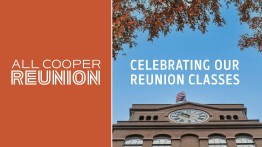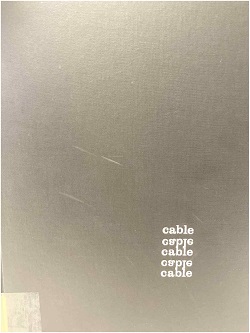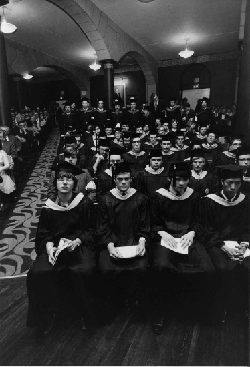Class of 1970

Reunion Class Anchors
Howard Amols PHY'70
John Gemski PHY'70
1970 Cable
111th Cooper Commencement
Do you have any fun materials from your college years that you would like to include on your class page, such as photographs or interesting documents? Please contact Alumni Affairs at alumni@cooper.edu.
Are you interested in being your class’s representative, helping with outreach and fundraising? Please contact Helen Freeman, Assistant Director for Alumni Affairs, at helen.freeman@cooper.edu.
Spotify Playlist
Alumni Bios & Updates
Jay Moskowitz PHY'70
Jay Moskowitz has spent his career as an inventor and serial entrepreneur, having started nine companies, His focus has been in wireless communication systems and systems for energy efficiency. He holds 15 patents. He has a long history of working on the bleeding-edge of technology and delivering unique never-before-seen products such as being one of the first to introduce the interconnection of the Internet (soon after switching from the Arpanet) to wireless devices for Email and web messaging. This was initially through beeper/pager wireless carriers and later to cellular providers. In 2014 Cooper Union awarded Jay the Gano Dunn Award for lifetime achievements in Engineering.
Jay has started yet another company that has created a handheld product that utilizes communication satellites to offer Emergency Messaging Services in the face of natural and man-made disasters, that operates anywhere on the planet when cellular systems fail. He is also a Director and Advisor to a firm using massive amounts of microalgae to reduce atmospheric carbon dioxide while producing food and pharmaceutical products.
Howard Amols PHY'70
After graduation I went to Brown University in Rhode Island (along with Menasche Nass and Bob McBride) and got my Ph.D. in nuclear physics in 1974. After grad school I received a National Cancer Institute post doctoral fellowship to work at Los Alamos National Laboratory on an new experimental program utilizing negative pi-mesons as a radiation therapy technique for cancer treatments. The cancer therapy program was one of a few islands of unclassified sanity in an otherwise bizarre factory town devoted to building nuclear weapons. After a 2 year postdoc I stayed on at Los Alamos as a staff member splitting my time between the pi-meson radiotherapy program and the Radiation Oncology Department at the University of New Mexico in Albuquerque, save one year off (1977-78) to work on a similar program in Karlesruhe Germany and Zurich Switzerland.
When it became clear to me that pion therapy was going to be a bust (looked good on paper, but in practice, less good!) I left Los Alamos and returned to Brown University as an Asst Prof in the Department of Radiation Medicine where I divded my time between clinical cancer treatments at Rhode Island Hospital, research, and undergraduate teaching.
Along the way I got married and had two kids, Amy and Rachel, now aged 49 and 45. They each have two sons aged 9-16.
I stayed at Brown until 1986 when I accepted a position as Assoc Prof (eventually full professor) and chief of radiation oncology physics at Columbia Presbyterian Medical Center in Washington Heights. In 1998 I moved cross town to become Chief of the Clinical Physics Service at Memorial Sloan Kettering Cancer Center (with courtesy appointment at Cornell Univ as Professor of Radiology in Physics) where I worked until my retirement in 2014. Along the way I received a couple of National Cancer Institute grants as well as industrial grants for studies related to dosimetry, radiobiology, and innovative clinical trials of new cancer technology therapies. I was president of the 6000 member American Association of Physicists in Medicine (AAPM) in 2005, and received the associations Edith Quimby Lifetime Achievement Award in 2014. My award certificate plus $2.75 now gets me a free ride on any NYC bus or subway!
After retirement in 2014 my wife (Nancy) and I moved to Allentown, Pa, following my older daughter and her two sons, but also to escape the noise and crowds of living in NYC, which after 30 years was starting to wear us down. We live now in a nice house in a quiet part of Allentown, with a nice garden, just down the road from a golf course, all of which cost less than half of what our apartment in Riverdale sold for. We spend many weekends in either NY or Philadelphia attending concerts, shows, operas, etc., and try to do one or two cruises every year. I'm still a `Senior Lecturer' at Columbia University where I give a few lectures per year in the Medical Physics Graduate program which I helped start back in 1992, and continue to serve on a few committees of the AAPM. One of the highlights of my year is the annual Cooper Union Alumni golf outing still organized by Dean Stephen Baker.
Robert W. “Bob” Moorhead CE'70
After growing up in the Flushing section of New York City, I moved to the Pacific Northwest a month after graduation in 1970, and except for occasional family visits and the Cooper 25th Anniversary Reunion in 1995, never looked back. I’ve lived in five communities with populations ranging from 2,880 to 125,000, and have had eight employers (3 cities, 2 consultants, 2 state agencies, and one federal agency).
I married Joy Phillips, an elementary school teacher from Spokane, WA, in 1984. We raised our son and daughter in Olympia, Washington, and they live nearby with their spouses and our four grandchildren. We moved to a smaller home in nearby Tumwater in 2018. I have been active in the American Public Works Association for 32 years, serving as an officer and the 2003 President of the Washington State Chapter. On the national scene, I was the last President of the APWA-sponsored Public Works Historical Society when it was disbanded by APWA in 2016. I retired on May 31, 2016, after a 46-year professional career.
For hobbies, Joy and I enjoy domestic travel, reading, and church and community involvement. So far in retirement we’ve visited 17 state capitol buildings, so we only have 33 to go! I have been a volunteer at the Olympia-Lacey Amtrak Centennial Train Station for 18 years, and a National Park Service Trails & Rails Guide on Amtrak’s Coast Starlight train between Seattle and Portland for eight summers.
Russell Hulse PHY'70
In 1966, a young man from a working-class family in the Bronx faced an indisputable reality: if he wanted to go to college, it had to be free. Russell remembers spending one Saturday, from 9 AM to 5 PM, “filling out little circles” on an endless exam to see if he’d qualify for The Cooper Union, a long subway ride and a world away from home. “To my amazement,” he recalls, “I got in!”
Cooper provided a launching pad for a stellar career: from here he soared to U Mass/ Amherst where he earned his PhD and as a grad student discovered the first binary pulsar—a celestial system in which two pulsars orbit each other—and would go on to earn the 1993 Nobel Prize for Physics. That year he was invited back to Cooper, to give his prize-winning speech in the Great Hall.
“I remember standing at the podium, amazed at the honor—and gazing out at the auditorium, I could spot the seat I sat in when I graduated,” Russell remembers. We asked him to share his fondest memory of his time at Cooper, and he didn’t hesitate: “I loved being a part of the Rifle Team!”
This group of 8 students—‘self-organized’ as Hulse explained—was firmly supported by Professor J. Clinton Hollinger, Cooper’s Director of Athletics, who supplied the ammunition, 22-caliber long rifles and cases that the team used, and found a young faculty member to coach them. One of the only women in the Engineering School at that time, Maxine Nietz CE’69, joined the team as well as they traveled weeknight practices at Brooklyn Tech high school’s basement shooting range and meets against rivals from NYU, City College and the US Merchant Marine Academy. The competition was tough—some of these institutions offered Rifle Scholarships!
“We’d pile onto the subway with these big, gun-shaped cases…” Russell reflected. “Slowly but surely, the other riders would edge away to the far end of the car once they discerned what we were carrying.”
The team also practiced at the rifle range in the woods at Green Camp, and it became clear that Hulse’s best friend, Tom Gulman EE’70, was the sharpest shooter of all. A successful shot from a standing, kneeling, or prone position became the group’s goal, and they honed their skills with determination.
Russell earned a minor letter his first year on the team…and 3 major letters in the years that followed. The team followed suit: starting in 16th place, they rose to a remarkable 3rd place citywide during Hulse’s tenure. Their success prompted a “prize” that still shines in Russell’s memory.
“Professor Hollinger was so proud of our team,” he recalls, “that he took us all out to dinner at a very nice restaurant. “ Sitting with his teammates at the elegantly-appointed table, with its linen napkins and candles, Russell reflected, “felt like coming in first! We—our family—didn’t go out to dinner. I felt so respected and proud…it’s a Cooper moment I’ll always remember.”
Angelo Turturro PHY'70
After graduating from Cooper, I got a job working in Brooklyn State Psychiatric Hospital for 4 years, an experience which helped me immeasurably in understanding our society. I decided I wanted to understand aging, so I took life science courses at Brooklyn College, & then got a Ph.D in Biophysics at Downstate Medical Center. After graduating from Downstate, in 1980, I went to work at the National Center for Toxicological Research in Jefferson, AR, part of the FDA, to work with the guy who ran the place. Before I could work on aging, I kept FDA & the Public Health Service happy by doing things like writing the cancer & risk assessment documents for FDA & the Office of Science & Technology Policy (the White House's science people) (one favorite was the one that looked at the safety of red lipstick) until I was able to start the Project on Caloric Restriction. This looked for at the mechanisms of aging using the only technique found in 140 years which actually consistently extended lifespan in mammals, collaborating with the National Institute of Aging, & involving over a hundred thousand animals. Afterwards, I helped figure out why the system that is used to measure toxicity was breaking down & also collaborated with EPA to actually run a P3 lab to work on a parasite we all have. I retired early to take care of family & have been living in Arkansas since, teaching a course at the local college on the Biology of Aging.
Mark Kaminsky PHY'70
Schooling
---------
MS (Physics), 1971, Stanford; PhD (Physics), 1976, Stanford.
Work History
------------
1976-1978 Asst Prof of Physics, Trinity University, San Antonio, TX
1978-1980 Software Eng; Singer's Kearfott Division, Wayne, NJ
1980-1989 Systems Eng, Software Eng; Singer's Link Flight Simulation Division, Sunnyvale, CA
1989-1997 Software Eng; ROLM (first part of IBM; then bought by Siemens; lots of name changes along the way), Santa Clara, CA
1997-1999 Software Eng; cc:Mail (part of Lotus, then part of IBM), Mountain View, CA and then Cupertino, CA
1999-2006 Software Eng; Edify (bought first by S1; then bought by Intervoice; I think it was later bought by someone else shortly before I got laid off. Santa Clara, CA
2007-2012 Software Eng; Blue Coat; Sunnyvale, CA
2012-2017 Software Eng; Hitachi Data Systems, San Jose, CA and then Santa Clara, CA
2017-2019 Software Eng; Peloton Technologies, Mountain View, CA
2019-date Retired
Family history
--------------
Married Peggy in 1974. Peggy had a long career as a registered nurse; she has now retired as well.
Two sons and a daughter; currently one grandson and four granddaughters, but stay tuned.
Business history
----------------
Peggy and I each became ASPO Certified Childbirth Educators (ACCEs).
After teaching for about ten years, I stopped when the necessary insurance jumped by a factor of eighteen in one year.
Pastimes
--------
Folk dancing
------------
Got introduced to folk dancing via a Cooper connection: I was wearing my Cooper jacket while collecting the fee for a Hillel lunch at Stanford. Janet paid, and told me that her brother had been a Cooper graduate. We got to talking, and then to dating, and she introduced me to folk dancing. I met Peggy at a dance in 1972. We were married just under two years later.
When we returned to California, we started dancing at one of the local junior colleges. A few years later, the teacher asked us to join his performing group, so we danced with them from 1986 to about 2000. We had many opportunities to travel with the group, including trips to Scandinavia and Austria (we combined the latter trip with a week in France with my nephew, who was there for a year of college).
We left the performing group in 2000, and have not danced much since.
Volleyball
----------
I got into a daily volleyball game at Stanford, and one of my claims to fame is that I am the reason that Sally Ride got a second place ribbon in intramural coed volleyball (without me, we would have had first place).
After Stanford, I did not play volleyball again until we moved to Sunnyvale in 1986, when I joined a Park and Rec volleyball class that I stayed in (with rare exceptions) until the early 2000's, then went back to it a few years later, and stayed through 2017. In 1994, the teacher gave out some Stanford Women's Volleyball posters, and that was the first I knew that there was a Stanford Women's volleyball team. It had started a couple of months after we moved to San Antonio, and it was not covered at all in the local newspapers despite winning its first national title in 1992. So I started going to games. I got my first season ticket for 1996.
I quickly became a fan of Division I Women's Volleyball in general. I reported on matches on the Usenet rec.sport.volleyball newsgroup from the late 1990's until around 2005, when teams started putting their results up on their own websites, so there was no need for me to spend the two hours or so it took me to write up a match.
I kept my season tickets until the pandemic. I am immuno-compromised and high risk, so despite doing all I can (I'm fully vaccinated and boosted, and have had a dose of Evusheld as well), it is simply not worth the risk to go.
Theater
-------
While in college, I attended many Broadway and off-Broadway shows. When we lived in New Jersey, we went to more. Now we have season tickets for TheatreWorks Silicon Valley and Opera San Jose. We've also been back to New York a few times, and gone to Broadway and off-Broadway shows.
Travelling
----------
In addition to the trips mentioned above, we have also been able to to visit New Zealand, Iceland, Canada (Toronto often, and once to Montreal), and Hawai'i (O'ahu, Maui, and the Big Island, many times).






